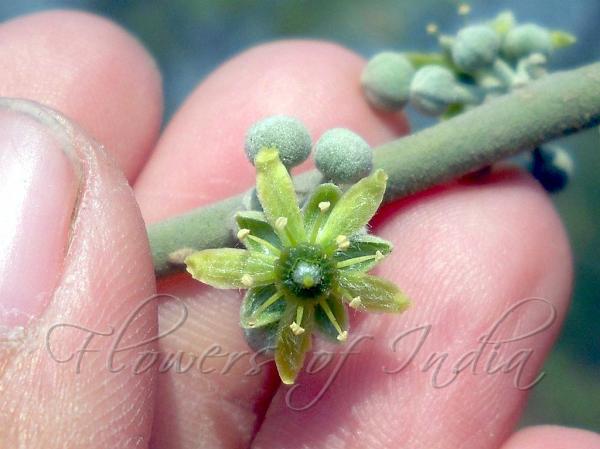|
| Desert Date |
|

|

| File size | 114855 |
| Original date | 3/11/12 10:06 AM |
| Resolution | 1024 x 768 |
| Flash | Flash did not fire, auto |
| Focal length | 6.72mm |
| Exposure time | 1/323s |
| Aperture | 5.5 |
| Focus Distance | |
| Metering Mode | Multi-segment |
| Camera make | NIKON |
| Camera model | COOLPIX L19 |
| Sensor type |
|
|
|
|
Photo: |
Botanical name: Balanites roxburghii Family: Zygophyllaceae (Caltrop family)
Synonyms: Balanites indica, Balanites rigida, Balanites jacquemontii
Synonyms: Balanites indica, Balanites rigida, Balanites jacquemontii
Desert Date is a small thorn tree or shrub,
with a generally narrow form. The branches are thorny. The dark
green compound leaves are made up of two leathery leaflets which are
variable in size and shape. Leaf-stalk is channeled, 0.5-2 cm with a
short rachis. Leaflets are entire, generally up to 6 cm long, 4 cm
broad, although can be smaller (1-3 x 0.3-1.5 cm). Greenish stalkless
flowers are borne in few-flowered fascicles. Flower buds are ovoid and
velvety. Individual flowers are 8-14 mm in diameter and generally
greenish-yellow. Flower-stalks are densely greyish, velvety and rarely
reaching 1 cm in length. Fruit is ellipsoid, up to 4 cm long, green.
Ripe fruit is brown or pale brown with a brittle coat enclosing a brown
or brown-green sticky pulp and a hard stone seed. The name Balanites
come from the Greek for acorn, referring to the fruit.
Desert Date is found throughout the
drier parts from Punjab to West Bengal, Rajasthan and Peninsular India.
Medicinal uses:  The fruits have been used in the treatment of liver and spleen
diseases. The roots are used for abdominal pains and as a purgative.
Gum from the wood is mixed with maize meal to treat chest complaints.
The fruits have been used in the treatment of liver and spleen
diseases. The roots are used for abdominal pains and as a purgative.
Gum from the wood is mixed with maize meal to treat chest complaints.
 The fruits have been used in the treatment of liver and spleen
diseases. The roots are used for abdominal pains and as a purgative.
Gum from the wood is mixed with maize meal to treat chest complaints.
The fruits have been used in the treatment of liver and spleen
diseases. The roots are used for abdominal pains and as a purgative.
Gum from the wood is mixed with maize meal to treat chest complaints.
| Identification credit: J.M. Garg, Jui Pethe | Photographed in Warora, Maharashtra & JNU Campus, Delhi. |
• Is this flower misidentified? If yes,